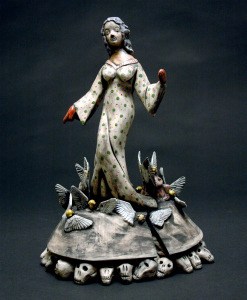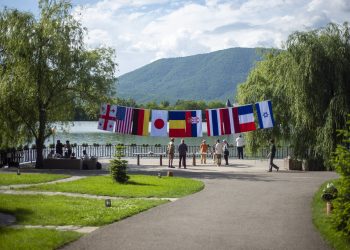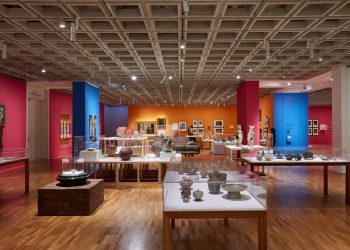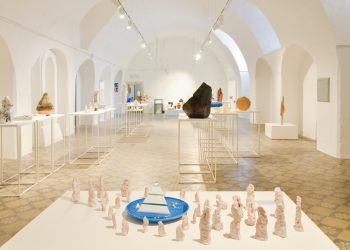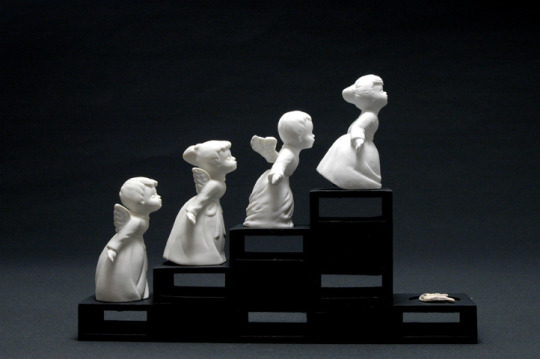
In what techniques do you usually work and what materials do you use?
Since I create more than one line of work, I’m afraid this will be a long answer! I have for a long time maintained both a sculptural and a functional line of ceramic objects.
My sculptural work incorporates handbuilt and slip cast components; found objects, and constructed objects of various materials (most often wood). Through hand building and slip-casting, the clay form is developed. I then use underglazes, engobes and China Paints to decorate the work.
My functional line of objects varies in terms of techniques all the time. I will sometimes throw porcelain or hand build dark mid temperature clays or slip cast forms. This is a process for me in which I aim to have fun simply, explore technique, and ideally constantly evolve. I love throwing with porcelain (Southern Ice in particular). My aesthetic leans towards more crisp, bright white objects with a bit of color added to glaze or underglazes. Lately, I’ve been developing a body of work that is inspired by my young son. I’ve been stamping and drawing (scraffito) a lot of cute imagery on my work. Surprisingly this work has been incredibly rewarding in that it simply brings joy and smiles to me as I make it, and to those that use it.
She felt like a joke and was falling a part at the seams, 2011, Mid-fired white stoneware, underglaze, china paint
What is your present project, what’s its history and how do you make the pieces?
My present project is a series of figurative sculptures that reference kitsch figurines, lowbrow art, DIY culture, and popular/ western/ consumer culture. Drawing from very personal narratives the work is an investigation into the human condition presenting figurative tableaus of death and love, hope and failure, family and social pressures. The aim of my work is always to stimulate conversation, thought and action in a pro-active method. I desire to address issues of political, social, humanitarian concern. Issues are taken from contemporary media but addressed through my own personal voice.
I have been working on this type of work for over six years now. There is always new subject matter to develop, more dialogues to be presented and discussed, new imagery that floats into my mind. As life changes, this body of work changes for me.
For this work I use vintage molds, handmade molds formed from found or hand-built objects, and I also handbuild a large amount of each piece. I work with a cone six white clay body (manufactured by Plainsman Clay) which I can purchase in both plastic and powder form. This way slip-cast and hand-built components can be easily attached without much fear of difficulties with compatibility. Each piece goes through multiple firings the top temperature being cone six. Once bisque fired, I cover each piece with a cobalt free black underglaze. I remove the bulk of this so that the black remains in the cracks and highlights the details of the work. I also like that this technique darkens the work. It removes the visual aesthetic from that of the kitsch object slightly so as to change the viewer’s expectations of the work. Sometimes I also use engobes (vitrified underglazes) to cover larger sections of color as a base coat. Pieces then go through a number of china paint firings. Each firing builds up layers of color. I enjoy working with the china paints, as it is a process that allows me to achieve strong and vibrant colors. There are always some finishing touches with these pieces, some gluing of components of a sculpture together or the addition of non-ceramic materials. The work is often displayed on wood bases and shelves or under glass domes for aesthetic and conceptual reasons.
What is the starting point in your investigation?
I began this sculptural project years ago as a graduate student. I was interested in tackling more political/social/humanitarian subject matter in my work, but had a lot of fear as to how to present such dialogues without them being overtly confrontational to the viewer. I also wanted to have an ethical standpoint from which to speak about the issues I chose to address. I didn’t want further to victimize the individuals that were directly impacted by the events. So I chose to speak through the mouthpiece of a mass produced consumer object; one that specifically held kitsch associations that I wanted to subvert. My initial desire to work with the collectible reference was in part due to its representation of aspects of childhood and nostalgia, kitsch and stereotypes, and most importantly – consumption. To speak of the subject matter that I was inspired to work with I chose to work from within my personal context as a consumer. This allowed for the presentation of the subject matter to include the impact that one has on it through simple daily actions. Through bringing the overwhelming and devastating nature of war, terrorism, poverty, starvation, genetic technology, and environmental degradation back to a dialogue about the individual consumer, I felt that I could offer more positive outlooks for pro-active change in regards to the issues.
In the past I have tackled all sorts of politically charged subject matter, however recently I have had more of a personal focus to my work in that I have been working to present dialogues regarding my concerns for my own child in our world. Becoming a parent brought all of these devastating events in the world into a new focus. The challenges of being a steward of ethical and moral behavior through personal action and the teaching of another generation have brought lots of new and exciting, albeit challenging subject matter into the work. It is my hope that through presenting very personal narratives and perspectives I might present a more inclusive and universal narrative of the human condition.
Force fed (2011) –
Mid-fired white stoneware, underglaze, china paint, found vintage objects.
What form of exhibiting do you like most, what suits you? Tell us about your past exhibitions or residencies.
I like to challenge myself by looking for different forms of exhibitions; be it groups or alternative spaces. I’m interested in how space impacts the presentation/reading of work; and also how exhibiting with other artists can add different levels of meaning to your work through the various threads of context that run from one artist’s work to the others.
In past exhibitions I have tried to show the work in different types of galleries, commercial, artist-run, craft based, etc. I think each space attracts different audiences with different perspectives and since so much of my passion is about communication with an audience I’m always eager to find and build new audiences for my work. I also really enjoy working online and sharing the work in that form. Although sculpture isn’t adequately presented in a two-dimensional image, showing work online exposes the work in ways that would otherwise be impossible. I often also try to share the work in progress online, to give an audience further insight into the work; it’s process and techniques as well as my thoughts and ideas that go into each piece.
A specific past residency that was very important to the development of my work was a residency in 2010 at the Medalta International Artist Residency in Medicine Hat, Alberta, Canada. It was there that I had the opportunity to work with a variety of vintage molds at one of the old factories near the residency site. I started to think a lot more about the use of these molds in my practice and have since been engaging with more dialogues regarding high and low art and contemporary perspectives on craft practice. It had always been an underlying theme to my work, but it is now one that I’m researching and developing to be more in the forefront of my subject matter.
There’s no place like home (2011) – View her works
Mid-fired white stoneware, underglaze, china paint, glitter, paint.
From your experience, tell us what did you learn from working with different materials?
What I have learned is that I’m not the best spokesperson for a purist approach to ceramics. Having the subject matter of my work trump the technical process (not that the technical process is irrelevant) means that I will do anything necessary in order to present the themes of my work adequately. I love clay; it’s process, and how it reads and feeds into my work. But at the end of the day if I have to paint something, glue something, or even build something out of a different material so that the subject matter of the piece comes across I will do that. I respect ceramic artists who are so compelled by the material that they won’t alter their processes for purity’s sake. Like the woodfirer who studies their kiln, their flame path, their reduction atmosphere so that they can know and understand it like the back of their hand. The Purity of material and process is an aspect of ceramics that makes it unlike any other material in my mind. It is part of why I work in clay. But more important for me is the reference of material to the incredible history of clay production and consumption globally.
Where can we find you and your works in the next future?
My next figurative exhibition opens April 15th, 2011 in my hometown of Saskatoon at the Mendel Art Gallery. I’ll also have work in an exhibition called Matter of Clay III at the Jonathon Bancroft Snell Gallery in London Ontario in August.
As for functional work, the best place to find it is either at one of the galleries that sell it (http://www.mysteria.ca/, http://www.thestallgallery.com/) or better yet find me and my work in person at some upcoming fine craft sales – all the details of when and where will be updated on my website: http://www.caroleepp.com/
Carole Epp is a Canadian ceramic artist and writer, who received her Masters Degree in Ceramics from the Australian National University. Her ceramics branch off into two distinct bodies of work wherein she produces lines of sculptural and functional objects. Her sculptural based work incorporates the production of collectible figurines whose traditional genre is subverted by revealing a more truthful representation of behaviour and morality in contemporary society.
Her work has been exhibited in Canada, Scotland, Australia and the United States. Her artwork and writing have also been published in the past few years in magazine publications, websites and books. She is editor of Musing About Mud an online blog which showcases information, calls for entry, exhibitions and artist profiles related to the ceramic arts.
By Vasi Hirdo.
Published in Ceramics Now Magazine Issue 1.
View Carole Epp’s profile on Ceramics Now.
Visit the Carole Epp’s website and her blog.


